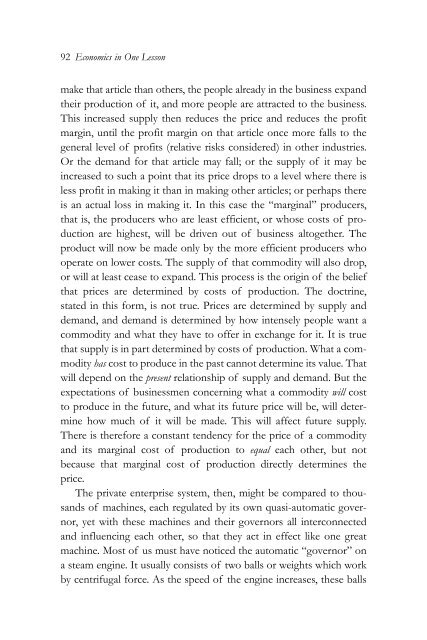1gDdM7w
1gDdM7w
1gDdM7w
- No tags were found...
Create successful ePaper yourself
Turn your PDF publications into a flip-book with our unique Google optimized e-Paper software.
92 Economics in One Lessonmake that article than others, the people already in the business expandtheir production of it, and more people are attracted to the business.This increased supply then reduces the price and reduces the profitmargin, until the profit margin on that article once more falls to thegeneral level of profits (relative risks considered) in other industries.Or the demand for that article may fall; or the supply of it may beincreased to such a point that its price drops to a level where there isless profit in making it than in making other articles; or perhaps thereis an actual loss in making it. In this case the “marginal” producers,that is, the producers who are least efficient, or whose costs of productionare highest, will be driven out of business altogether. Theproduct will now be made only by the more efficient producers whooperate on lower costs. The supply of that commodity will also drop,or will at least cease to expand. This process is the origin of the beliefthat prices are determined by costs of production. The doctrine,stated in this form, is not true. Prices are determined by supply anddemand, and demand is determined by how intensely people want acommodity and what they have to offer in exchange for it. It is truethat supply is in part determined by costs of production. What a commodityhas cost to produce in the past cannot determine its value. Thatwill depend on the present relationship of supply and demand. But theexpectations of businessmen concerning what a commodity will costto produce in the future, and what its future price will be, will determinehow much of it will be made. This will affect future supply.There is therefore a constant tendency for the price of a commodityand its marginal cost of production to equal each other, but notbecause that marginal cost of production directly determines theprice.The private enterprise system, then, might be compared to thousandsof machines, each regulated by its own quasi-automatic governor,yet with these machines and their governors all interconnectedand influencing each other, so that they act in effect like one greatmachine. Most of us must have noticed the automatic “governor” ona steam engine. It usually consists of two balls or weights which workby centrifugal force. As the speed of the engine increases, these balls


